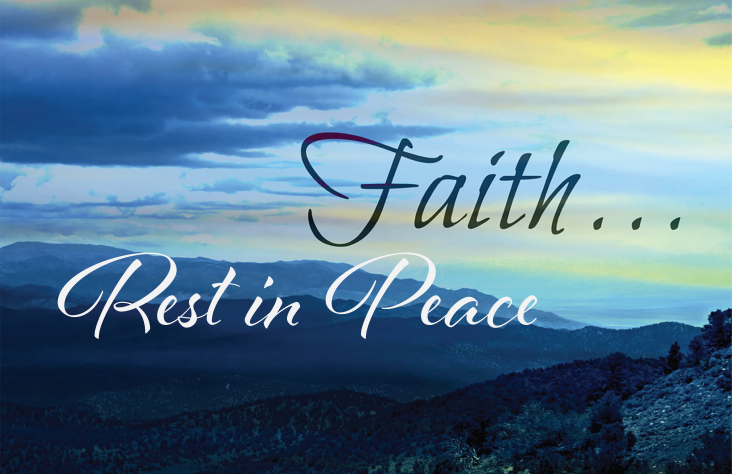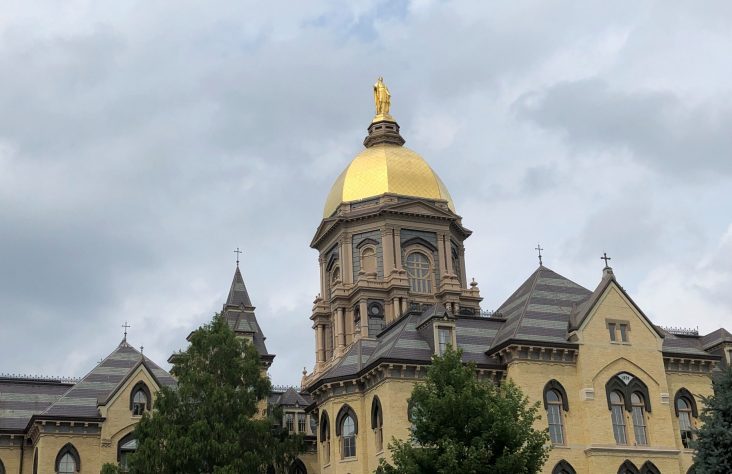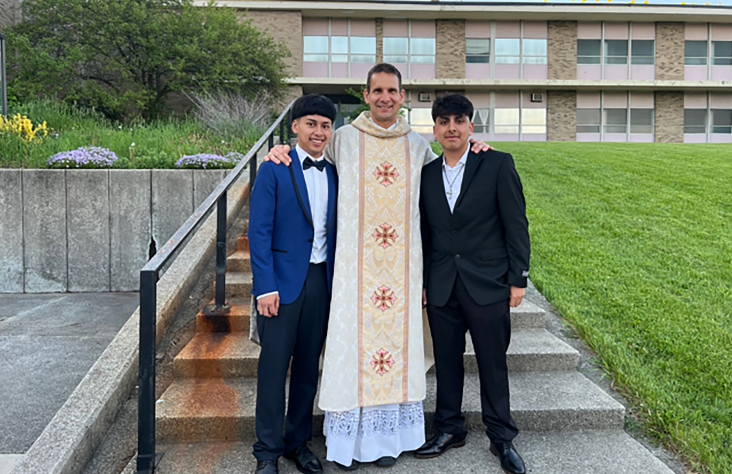June 23, 2014 // Uncategorized
St. Mary, Mother of God, parishioners connect with their history

Bishop Kevin C. Rhoades celebrates the feast of Corpus Christi at St. Mary, Mother of God Church in downtown Fort Wayne on June 22. At the Mass he blessed a tabernacle that was restored with salvaged pieces from the church that was destroyed by fire in 1993.
By Mark Weber
FORT WAYNE — Parishioners at St. Mary, “Mother of God,” recaptured a bit of their history on June 22. Celebrating Mass on the solemnity of The Most Holy Body and Blood of Christ, Bishop Kevin C. Rhoades reminded the parishioners that Mother of God is part of the historical downtown Fort Wayne’s church’s title and blessed a restored tabernacle with parts that were salvaged from a 1993 fire that destroyed the old church.
In his homily, Bishop Rhoades explained that he had received a letter from Father Phillip Widmann requesting that the parish and church title be “Mary, Mother of God” (“Muttergottes” in German). In his research, Bishop Rhoades discovered that Bishop John M. D’Arcy kept the same title and dedicated the new church to “Mary, the Mother of God.”
“So I let Father Widmann know that this ‘is’ officially the title of your church and parish,” Bishop Rhoades said. “The parish feast day, therefore, is Jan. 1, the solemnity of Mary, the Mother of God.”
“This is the most ancient title of Our Lady, a title confirmed by the Council of Ephesus in the year 451,” Bishop Rhoades said. “This title was an affirmation by the Church not only of Mary’s identity, but also a defense of the truth about the identity of Christ as God, that He is the Son of God, one Divine Person, the second Person of the Blessed Trinity, with two natures, human and divine. Since Jesus is truly God from God and consubstantial with the Father, as we profess in the Nicene Creed, His mother is rightly called the Mother of God.”
Bishop Rhoades recalled how St. John Paul II called Mary the “Woman of the Eucharist.”
“It is great to be with you today on this beautiful feast of the Holy Eucharist, Corpus Christi,” Bishop Rhoades said. “Very appropriately, on this feast I will bless your beautiful new tabernacle where the Blessed Sacrament will be reserved so that holy Communion can be brought to the sick and the dying. The Eucharist is reserved in our churches also for your prayer and Adoration before the Blessed Sacrament.”
“This tabernacle is very special since parts of it were built from pieces of the old tabernacle that were preserved from the fire of 1993,” he said. “It connects you with your history and the thousands of ancestors in the faith here at St. Mary’s who prayed before the old tabernacle. The parts that have been preserved, as you probably know, are the brass doors and the two marble side pieces with lilies (the lily being a symbol of Mary).”
Bishop Rhoades spoke of St. John Paul’s encyclical letter written on the Eucharist. The pope wrote: “the Eucharist, as Christ’s saving presence in the community of the faithful and its spiritual food, is the most precious possession which the Church can have in her journey through history.”
Bishop Rhoades said, “Today, on this special feast, we thank Christ our Lord for this amazing gift. The Eucharist is truly the Church’s most precious possession! It is the greatest of the sacraments.”
“When we receive Holy Communion, we receive the most holy Body and Blood of our Lord,” he said. “As Catholics, we firmly believe the words of Jesus in today’s Gospel: ‘I am the living bread that came down from heaven; whoever eats this bread will live forever; and the bread that I will give is My flesh for the life of the world.’”
The Eucharist is the food for our journey through life, the bishop said.
Near the end of his encyclical on the Eucharist, St. John Paul II wrote: “In the humble signs of bread and wine, changed into His Body and Blood, Christ walks beside us as our strength and our food for the journey, and He enables us to become, for everyone, witnesses of hope. If, in the presence of this mystery, reason experiences its limits, the heart, enlightened by the grace of the Holy Spirit, clearly sees the response that is demanded, and bows low in adoration and unbounded love.”
After the homily, Bishop Rhoades blessed the tabernacle.
Ken Yahne, longtime member, recalled salvaging relics after the fire: “I remember after the fire 1993 being in the church, taking apart the altar to get to the relics, literally taking it apart brick by brick and it was amazing to see the destruction caused by the falling timbers. The altar was crushed.”
“When we created the new building, we built a 5,000 square-foot soup kitchen, which is the mainstay of our social ministry,” Yahne noted. “The old building was destroyed, the spirit of St. Mary’s lives on.”
Therese Spencer, former RCIA director at the parish and now the religious education director, said, “When the fire happened, I wasn’t here yet, but when I became RCIA director in 1998, a lady came through RCIA who had witnessed the actual lightning strike and saw the burning fire and said that moved her so much that she began looking into the Catholic faith. She felt like God got her attention and from that she became a Catholic. She was in my first class to be brought into the Church. So that’s my memory of the fire.”
Jan Kortenber, office manager at St. Mary Mother of God Church since 2002, said, “The tabernacle is fabulous. I love seeing the old blended with the new, and Bishop Rhoades is always inspiring. I have never been in his presence when he was not inspiring.”
Tim Johnson contributed to this article.
Ruined tabernacle restored to glory
By Mark Weber

Mark Weber
Woodworker Tom Braun stands by the restored tabernacle of St. Mary Church, Fort Wayne. Braun fashioned the new tabernacle from two pieces of marble and brass doors, which survived the 1993 fire that destroyed the church.
FORT WAYNE — On a lazy day late in the summer of 1993, as Fort Wayne folks waited for the Labor Day weekend to kick in, a supercharged lightning bolt blasted the steeple of St. Mary Church downtown Fort Wayne zipping flames everywhere through the century old mainly wooden house of God and beloved Fort Wayne landmark. There was no question of controlling the flames and sadly, the fireman’s old joke, “We saved the foundation,” said it all.
For a long time the busy traffic on Lafayette Street rolled by the rubble wrapped in wire fencing. Destruction was nearly total, yielding little in the way of salvage.
Surprisingly, among broken pieces set aside was a vital item encrusted with cinders and stains and lay hidden in the rectory garage with unexamined debris for nearly two decades. Metaphorically, the hidden item symbolized the impossibility of destruction of the Divine Presence; charred and unrecognizable, it was the original tabernacle.
Following discovery of the brass tabernacle door and two marble sidepieces, the marble was sent to Classic Marble and Stone Company in Hoagland for restoration and the brass doors, with six brass candleholders were sent to a company in Detroit for regilding.
Once this cleanup was complete, the real challenge presented itself — how to make two marble slabs and brass doors go together as a tabernacle. Through the mysterious goodness of God, the assignment went to the skilled hands of Tom Braun, a longtime parishioner of St. Vincent de Paul Parish in Fort Wayne. Braun is a retired pattern maker, affectionately nicknamed “St. Joseph” by the priests who call on him to design and build custom made church furniture.
Using beautiful cherry wood, Braun fashioned a triptych-style form with the brass doors as the centerpiece and the marble panels bearing lily designs as the sidepieces. The tabernacle is designed to support a monstrance for occasions of Divine Exposition.
Also found in the ashes and saved was a marble panel bearing the names of German families who mortgaged their farms to acquire the land for the future St. Mary Church as they separated from St. Augustine, (Fort Wayne’s first Catholic church and immediate predecessor of the Cathedral of the Immaculate Conception) in order to have a German parish with Mass in Latin but sermons and announcements in German, all under the name of Der Mutter-Gottes Kirche, the Mother of God Church. Honoring the spirit of these charter members and knowing that conversationally the church will continue to be called “St. Mary’s,” the church is officially listed as St. Mary, Mother of God Church.
The best news. Delivered to your inbox.
Subscribe to our mailing list today.






